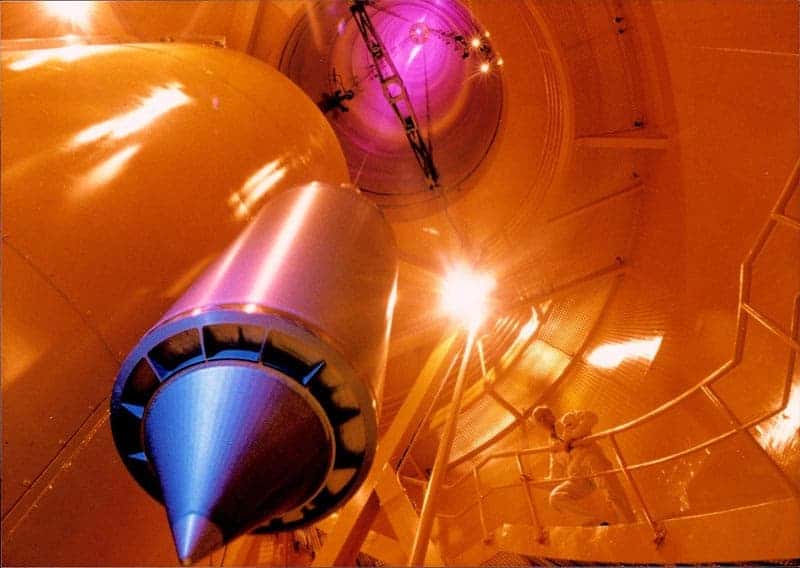Rocket carries Bose-Einstein condensate into space
17 Oct 2018
A Bose-Einstein condensate (BEC) has been created in space by a global team led physicists in Germany. During its 6 min of freefall, over 100 experiments were performed on the BEC. This marks a significant advance on previous microgravity experiments involving BECs, in which single experiments were performed during a few seconds of free fall down a drop tower. More significantly, it constitutes a significant step towards placing a BEC in zero gravity on the International Space Station, which could open the door to vital experiments in multiple areas of physics.

BECs are ensembles of atoms with integer quantum spins. This means the atoms are not bound by the Pauli exclusion principle and, when chilled to near absolute zero temperatures, they can all occupy the ground state of a system simultaneously. They therefore behave as a single, macroscopic quantum object. The first BEC was created in 1995 and have since proved useful for experiments in various areas of physics, ranging from quantum optics to cosmology.
Like any quantum state, a BEC is highly fragile, which makes it extremely useful as a sensor of external forces such as gravity and magnetic fields. However, this fragility also means that a BEC can easily be destroyed by contact with its surroundings. Therefore researchers take great care to shield BECs from heat and electromagnetic fields. One cannot shield an experiment from gravity, however: “We often want to use atom interferometers to measure inertial forces such as rotation and acceleration,” says Dennis Becker of Leibniz University Hannover, “You get a large bias if you have gravity.”
Three drops per day
As Einstein’s famous equivalence principle dictates, an experiment conducted in freefall is locally indistinguishable from one conducted in zero gravity. On this basis, in 2007 Ernst Raseland colleagues from Leibniz University of Hanover and elsewhere prepared and observed a BEC inside a capsule while it was falling down the 146 m ZARM drop tower in Bremen. The researchers noted that the condensate was significantly more stable than in a laboratory fixed to the Earth. However, they could perform at most three drops per day, and in each drop the condensate spent less than 5 s in free fall. As a result there has been an ongoing drive to produce BECs in orbit around the Earth and in May 2018 NASA launched its Cold Atom Laboratory to the International Space Station.
In this latest work, Becker, Rasel and colleagues have taken a different route into space by loading an “atom chip” onto a rocket. The atom chip comprised a micron-scale magneto-optical trap containing rubidium-87 atoms. The chip was held within a 3 m capsule containing electronics, lasers and a power source. This was mounted onto a MAIUS-1 rocket, which was fired 243 km upwards from a launch site in Sweden in January 2017. When the rocket reached its zenith, the researchers immediately cooled the atoms by forced evaporative cooling – successfully creating a BEC of around 105 atoms in just 1.6 s.
In the subsequent 6 min of free fall, the researchers managed to conduct 110 experiments on the condensate. Becker explains that this was due to careful forward planning and artificial intelligence. The team pre-programmed sequences of experiments in which one parameter changed from experiment to experiment. “The experimental apparatus would do some of the experiments but also evaluate them to some degree so it could take the best value for the next experiment,” says Becker.
The main goal was to get the technology ready for a future mission where there might be surprising scienceDennis Becker
The researchers found that their results compare well with similar experiments done here on Earth. “In the sense of ‘Is there new physics that was not predicted by theory?’ I would say no,” says Becker “But the main goal of this mission was to get the technology ready for a future mission where there might be surprising science.” On future launches, for example, the researchers want to produce combined condensates, which could be used to test the equivalence principle.READ MORE

“The spectacular thing is that you can do [the experiments] in a rocket,” says cold atom expert Jakob Reichel of Ecole Nationale Superiéure in Paris. He adds that the demonstration was so convincing that the technology could be handed over to engineers for further development.
The research is described in Nature.
Tim Wogan is a science writer based in the UK
17/10/2018 from physicsworld.com

Δεν υπάρχουν σχόλια:
Δημοσίευση σχολίου